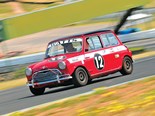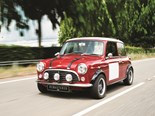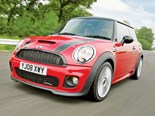Flashback: Old & New Mini Racers































|

|

|

|

|

|

|

|

|

|

|

|

|

|

|
Can the Gen Y Mini Challenge racer deliver the same racetrack smiles as its Baby Boomer progenitor? Michael Browning time travels 40 years to find the answer
From Unique Cars #285, Apr/May 2008
Old & new Mini racers
Michael Stillwell and I have a couple of things in common, apart from sapping the planet’s resources for similar periods of time.
We both share a passion for rear-engined Porsches dating back many years. Michael was the founding president of the Porsche Club of Victoria in 1975 and owned a string of road and rally 911 models since before his family’s BMW business interests detoured him to Bavaria, while my sojourn to Stuttgart began in the early-’80s.
Yet incongruously, we also share a love for cars with the powertrain congregated at the North, instead of the South Pole. As of March this year, we can both claim the title of Mini racers, although his prefix is spelt in capitals and mine reverts to upper and lower case.

The original has its own place in motorsport history while BMW’s new-gen offering is still in the process of writing its own
In the early-’70s, I was racing naturally aspirated and supercharged Cooper S models in Rallycross at Calder and Catalina Park, whereas Stillwell was engaged in a similarly short (but much more successful) circuit racing career in an Alan Mann-built RS1600 Escort, that climaxed in him becoming the 1972 Australian 2.0-litre Touring Car Champion.
By that stage the Mini Cooper S was already yesterday’s race car. The merging of the Series Production and Improved Production categories under new regulations introduced in 1973 comprehensively outclassed the giant-killers of the ’60s and forced the existing cars into the ranks of Sports Sedans.
| Read next: Mini Cooper factory race replica
However, not content to play second fiddle to the highly-modified V8 Fords and Holdens, the Mini racers of the day got together to form the Super Mini Series, which ran successfully as a stand-alone category for several years, with fields of up to 20 or more cars competing at its peak.
Crossflow cylinder heads, modified lightweight bodywork and a number of other freedoms allowed under the Sports Sedan rules turned these Minis into fire-breathers.
But while far removed from the benign Mini Clubman models of the day, these hybrids effectively became the forerunners of the 2008 Mini Challenge racers we have today.

At the State Motorcycle Centre at Broadford north of Melbourne, Unique Cars assembled two racing Minis separated by more than four decades to see whether any of the original Mini racing spirit had been distilled into the latest BMW-built Challenge cars.
For Michael Stillwell, who made his new Mini racing debut aged 57 in the opening round of the 2008 Challenge at Sydney’s Eastern Creek in March, it is his first experience at the wheel of an early Mini racer; for me, it’s a reunion with an old friend and a first taste of the future.
| Read next: 2008 Mini John Cooper Works review
Both cars are part of the extensive and ever-growing Stillwell racing stable. As a leading Melbourne Mini dealer, the Stillwells are running three cars in the Mini Challenge – one car co-driven by Michael and his youngest brother Nicholas (aged 40); another leased out to 2007 Australian Performance Car Champion Garry Young, while the Stillwells also maintain a third ‘VIP’ Mini for BMW Australia.
The car at Broadford is the Stillwell/Stillwell race car, fresh from its debut in Michael’s hands at Eastern Creek 12 days earlier, where it qualified 11th out of the field of 17 Minis and finished a best of ninth in the second race.

Separated by more than 40 years of technological advances the original Cooper S still offers heaps of driver enjoyment
Nick Stillwell also races an early Mini Cooper S in Historic events. He became interested around 10 years ago and soon was beating the Cortina of older brother (and Stillwell CEO) Chris Stillwell. But jealous of the constant smile on Nick’s face, Chris asked Stillwell Motorsport’s Race Manager Euan McDonald to build him an identical Cooper S.
Starting life as a 1964-model Mini DeLuxe, that second historic Cooper rolls out of the Stillwell race transporter at Broadford in brand new condition, having only been taken for a brief run around the block the night before.
We toss for first drives and I win the Historic Mini, while Michael re-acquaints himself with the Challenge car.
Painted like the original Neptune Racing Blue that Peter Manton, Jim McKeown and Norm Beechey wore on their Mini, Cortina and Holden S4 respectively when they ran as a team in the early-’60s, the Mini looks superb and reassuringly familiar.
Opening and shutting the doors produces a familiar dustbin-lid ‘clang’ thanks to the lack of interior trim and after slipping easily through the new chrome-moly roll cage the Velo racing bucket is a comfortable place to view the sparse dashboard ahead.
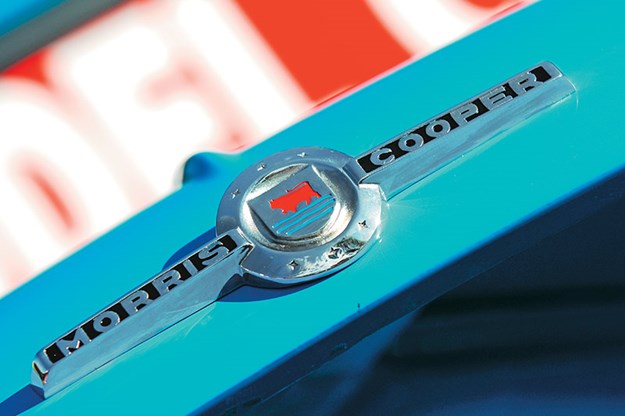
Apart from the central switchgear, the central binnacle was retained only for decoration, with a supplementary panel mounted ahead of the driver now housing the 10,000rpm rev counter (red-lined at 8000rpm), and traditional Smiths oil and water gauges.
The only other obvious changes from standard layout are the alloy pedals, the drop-link to lower the steering column, the quick removable leather-rimmed period-style steering wheel and the lock-out cable for reverse gear, fashioned from a Mini choke cable.
Firing the slightly-overbored 1293cc engine via the extended ignition key brings a magnificent explosion, with the single 45mm twin-choke Weber sucking like Maggie Simpson.
While the engine had not yet done a tour of duty under the bonnet, Euan assures me it had dynoed at a very healthy 140hp (105kW) on the bench and was ready for a workout.
With its lightened flywheel, free-flow headers and throaty exhaust system, it revs instantly and enthusiastically, flooding me with memories of those good vibrations many years ago.
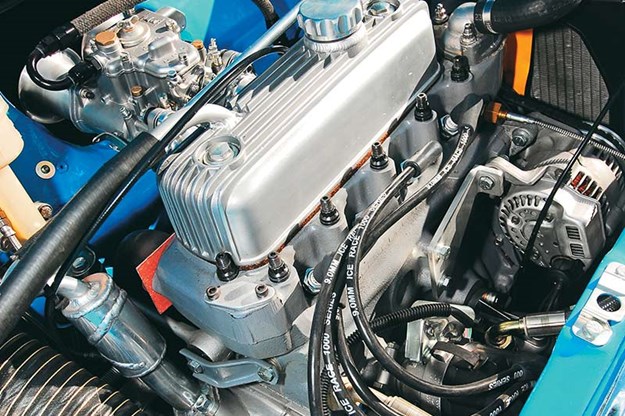
Exploring the flowing and undulating Broadford circuit is instantly a delight. Unlike many Mini racing gearboxes, this one with its straight-cut, close-ratio cogs is a ripper – fast, smooth and very direct with its shortened shift urging me to explore all four gears at every opportunity.
The ride feels more comfortable than I recall from my Rallycross days, despite the adjustable Spax shockers and rubber cone suspension replacing the car’s original Hydrolastic set-up, but as this was the car’s race circuit debut, stiffer settings could be dialled up with greater familiarity.
To get more traction on the unsealed sections of the Rallycross circuits, my Mini had a fully-welded differential that allowed the car to be ‘backed’ into corners on the brakes and then powered out without excessive understeer. To my surprise, the Stillwell Mini handles much the same way, the result of its soft rear suspension settings and Salisbury limited slip differential.
After so many years out of the saddle, this feels a little unsettling at first, as though the rear suspension is unhinged. But after overcoming the fear that I am about to be overtaken by the rear bumper, I find the car can be set up for fast and slow corners alike by a quick lift on the accelerator, a dab on the brakes and then a decent boot from my right foot.
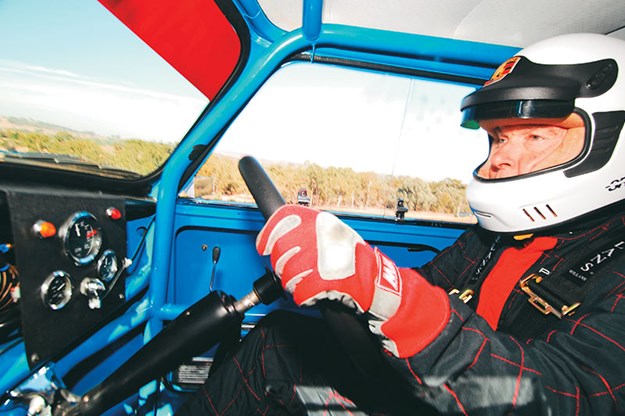
More familiar with the older version, Browning gives this 1964 Cooper S the nod over its modern counterpart
Those brakes – solid Brembo front rotors with Cooper S callipers and Portafield racing pads up-front – are the only unsettling bit until they get warm, but then it’s all a hoot and I don’t want to stop until I see the fuel gauge winking orange and Michael Stillwell waiting by the pit wall ready to swap cars.
His Mini Challenge car is burbling quietly away at idle when I slip through the comprehensive cage into its Recaro racing seat; ahead of me is an instrument-studded dashboard delivering considerably more information than was available in the 1960s.
Despite the impressive 154kW/280Nm (with overboost) produced by the John Cooper Works 1.6-litre engine fed by twin scroll turbochargers, the vehicle proves remarkably refined and tractable from idle speed upwards.
As the Challenge cars’ identical race ECUs are only distributed at race weekends, the difference between Minis comes down to chassis settings and weight. Just about everything is adjustable, from toe-in and camber to front and rear ride height, while double-acting adjustable shock absorbers all-round mean that you can also play with bump and rebound.
Finally there are tyre pressures, with most of the teams fine-tuning their settings with a tyre pyrometer.

Michael Stillwell gets to grips with his ‘Challenge’ car. Mini Challenge offers the chance to campaign cutting edge machines at realistic prices
"With 280Nm on tap, it really wants to spin its wheels everywhere," warns Michael. "At Eastern Creek Turn 8, which is a fourth gear downhill left-hander that you probably take at about 150-160km/h, we’re wheel-spinning under full power.
"The trick is in the set-up. What we’re trying to achieve is a variation in front/rear grip level that will allow us to whistle into a corner, jump on the brakes, let the back come around and accelerate out pointing where we want to go."
Being the first round of the 2008 Mini Challenge made Eastern Creek a steep learning curve for most of the teams.
"We soon learned that with the right set-up and a few brave pills we were able to take Turn 1 flat, which meant we could gain 50-60m on those that weren’t quite game enough," says Michael.
"But you’ll see further chassis development in later rounds as everyone learns the tricks. Yet even as they were, we were lapping around 5-6secs a lap quicker than the V8 Brutes at the same meeting.
"Until Eastern Creek I had never raced a front-wheel drive car before and the overall grip level was far in excess of anything I’ve ever experienced. You carry so much corner speed that when you start sliding, both ends go together and you end up sliding off the track…"

After this warning I expected a beast, but after experiencing its 1964 forebear, the Challenge car is remarkably familiar in many fundamental ways.
With a minimum weight of just 1150kg to haul, including the driver, the Mini Challenge favours jockeys and my 70kg proves little obstruction and acceleration via the stock six-speed gearbox is exciting rather than neck-snapping.
More impressive is the engine’s torque from even quite low revs, which results in plenty of power on tap to haul you out of a corner or a tricky situation if you get it wrong.
In total contrast to the early Mini, the Challenge car’s quick-ratio power-assisted steering proves super sensitive, so it was easy to oversteer and induce power-on understeer in tight corners until I became familiar with it.
Equally sensitive and extremely powerful are the car’s race-spec ABS brakes, which haul the car back like a bungy cord with just a feather touch on the pedal. Mini quotes an impressive 100km/h-0 stopping distance of just 31m.
Like the early Mini, cracking into a corner fast sees the tail step out marginally as I lift off the accelerator and onto the brakes.
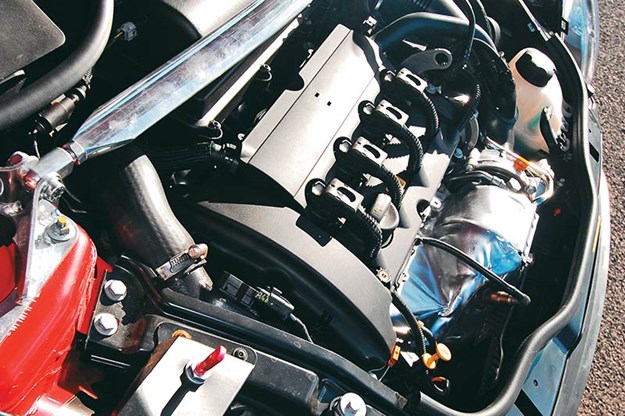
Apply too much power and you run the danger of missing the apex, with the trick being to aim at a point just before the apex and let the car’s natural understeer kiss the mark.
Along with their adjustable suspension, the Challenge racers also come with a large rear roof-mounted wing adjustable to five separate positions, although Ude Mark, the worldwide coordinator of Mini Challenge told entrants at Eastern Creek that anything more aggressive than the most level position would have a serious effect on top speed.
After a dozen or so laps, feeling braver each time, it was time to join Michael Stillwell in pit lane and compare notes.
It was hard not to be impressed by the track acumen of the Challenge car, even at its ‘retail’ price to Series entrants of $97,900 (inc GST).
It’s a properly set-up, very professional and surprisingly-rapid race car, with ample opportunity for individual tailoring and a lot of fun to drive fast.
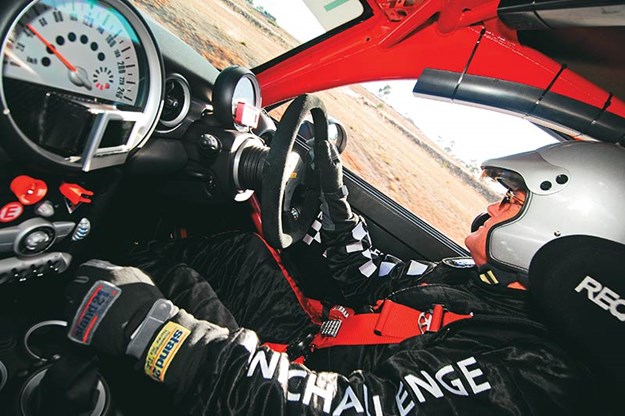
Yet it’s pretty much mechanically bullet-proof and very safe, which makes it an affordable proposition for those who can’t make the much bigger stretch to a Porsche Carrera Cup car, which is its nearest racing equivalent.
Then there’s the old Mini, worth fully built and ready to race perhaps half the price of the Challenge car, but more maintenance intensive.
Perhaps for all the wrong reasons, I find myself edging towards the 1964 car. There is something about its raucous sound and raw fun that remains as infectious and appealing today as it was in the ’60s.
But with no early Mini bonding experience, you can tell Michael Stillwell’s allegiances are to the 21st Century.
"I love the mechanical sound of the early Mini and the smell of the oil that you don’t get today," he said. "It’s just lovely – like a go-kart.
"But to me the latest Mini is more predictable to drive and you use the steering wheel to place the car, whereas in the early Mini you really have to hang on and wrestle it.
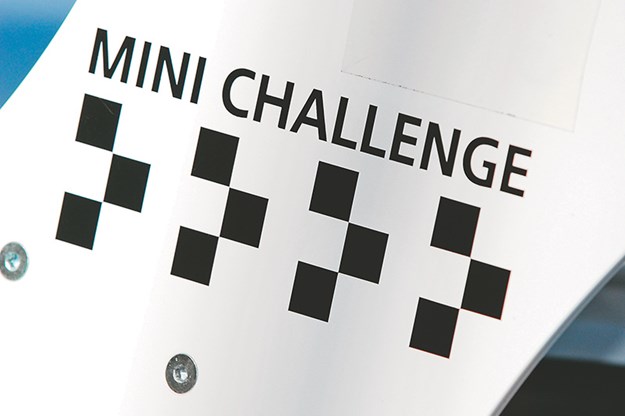
"I have a huge admiration for the guys that can drive those early cars fast, but I’m not going to be one of them!"
MODERN CHALLENGE
Making its debut in Australia in 2008, the Mini Challenge is an international one-make racing series styled on the Porsche Carrera Cup.
Drawing on four seasons’ history in Europe, the 2008 R56 Mini Challenge race cars feature a 154kW/280Nm John Cooper Works engine, but in their new race guise, boasts a twin-scroll turbocharger rather than a supercharger.
Cars cost $89,000 (plus GST) ready-to-race with all safety equipment, but can only be campaigned by entrants who enter into a Teams Agreement for a one-off payment of $33,000. This agreement is for a five-year term and is transferable with the sale of a vehicle.
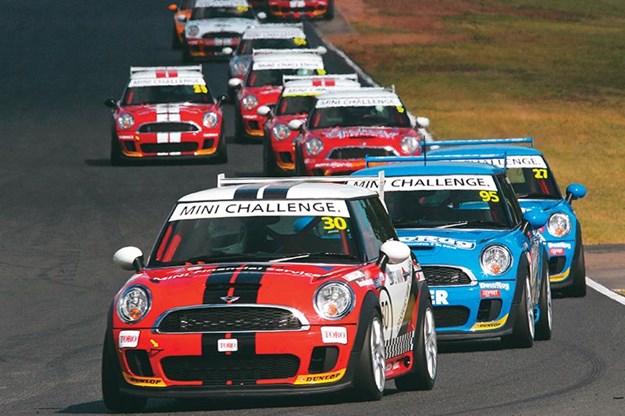
In addition, entrants paid an annual fee of $45,000, which covers all entry fees, pit garage facilities, team catering, and contribution to the television coverage and series administration.
Competitors must hold a minimum of a C3 CAMS licence and for the Bathurst round, the minimum of a National Circuit (formerly C4) licence.
The first round of the eight-round series was held at Eastern Creek on March 7-9 with the overall winner 24-year old former Gold Star champion, Neil McFadyen.
1964 Mini Cooper S race car/2008 Mini Challenge race car specs
Body: standard steel Mini with sliding side windows/JCW Aerodynamics Package with front spoiler, adjustable rear spoiler and rear diffuser, air pressure jack system
Weight: 600kg (approx)/1150kg (max) including driver
Engine: 1293cc naturally-aspirated four-cylinder/1598cc turbocharged four-cylinder
Transmission: four-speed manual/six-speed manual
Power/torque: 105kW/NA/154 kW/280Nm
Drivetrain: front engine, FWD
Performance: 0-100km/h – NA/6.1secs. Top speed – NA/240km/h
Suspension: independent by rubber cone springs and Spax adjustable shock absorbers/independent by MacPherson spring struts and trailing arms with two-way adjustable shock absorbers
Brakes: race-spec Brembo front discs, rear drums with racing pads and linings/race-spec ABS disc brakes front and rear
Steering: non-assisted rack and pinion/EPAS (Electrical Power Assisted)
Wheels & tyres: 10inch mag, 165/70-10 Yokohama A032R sport tyres/17inch Mini Challenge alloys, control Dunlop racing tyres
Safety: CAMS chromemoly rollcage, six-point safety belt, manual fire extinguisher, racing seat/rollcage, six-point safety belt, automatic fire extinguisher, racing seat and Head And Neck Support (HANS) Device
Unique Cars magazine Value Guides
Sell your car for free right here
Get your monthly fix of news, reviews and stories on the greatest cars and minds in the automotive world.
Subscribe

.jpg)








